
http://bio.usuhs.mil/biochem4.html |
1. Making a copy of DNA is called __________________.
2. Which nitrogen base isn’t used during
this
process?
3. Name the enzyme you learned about that adds the complementary
nucleotides and spell checks in the picture above.
|
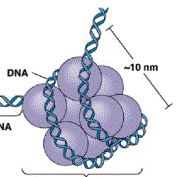 |
4.
The beadlike bundles that form when DNA wraps up are called
_________________.
5. Name the protein in the center of the bundle that DNA wraps around.
Image from:
Biology; Miller and Levine; Pearson Education publishing as Prentice
Hall; 2006
|
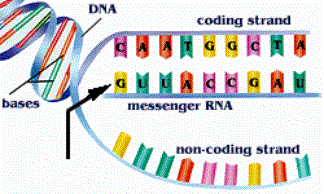 |
6. This process of copying an RNA message from the DNA code is called
____________________.
7. Tell where in the cell this happens in a eukaryotic cell.
|
Image from:
http://www.wappingersschools.org/RCK/staff/teacherhp/johnson/visualvocab/mRNA.gif
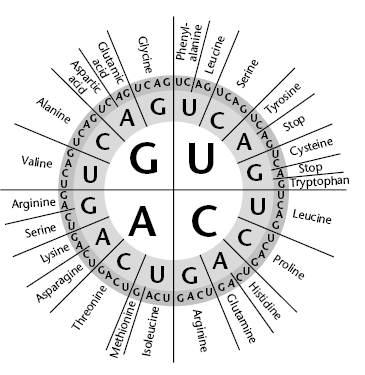 |
8.
USE THE mRNA CODE WHEEL
to tell the amino acid sequence coded for by the following message:
U C
A C G A G U C
|
9. Which kind of RNA has an ANTICODON region and carries the amino acids to the
ribosome?
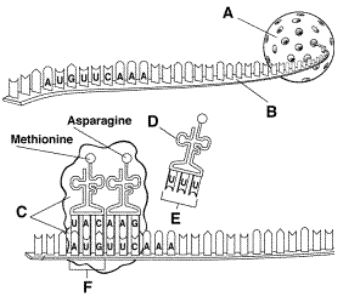 |
10.
B =
?
11.
F = ?
12. C = ?
|
Image from:
Biology; Miller and Levine; Pearson Education publishing as Prentice Hall;
2006
13. Tell one way DNA is different from RNA.
14. Tell the enzyme that adds the
nitrogen bases when making an RNA message from DNA.
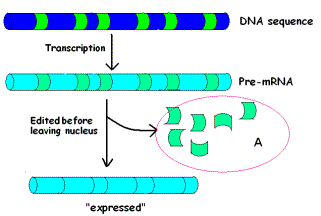 |
15.
What do we call the small pieces of DNA that are edited out of the mRNA
message before it is expressed? |
16. Tell what form DNA would
be found in during REPLICATION and TRANSCRIPTION.
CHROMOSOMES
CHROMATIN
17. When making DNA, CYTOSINE always pairs with _______________________.
 |
18. Using an RNA message to make a protein is called
______________. |
 |
19.
Name this subunit used to build DNA and RNA.
|
20. Tell the complementary DNA
strand for the DNA sequence shown.
A T T G C C
A G C
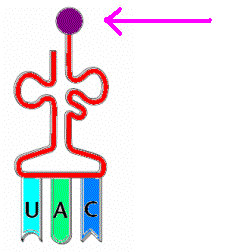 |
21. Name this kind of RNA.
22. Name the molecule attached here.
Image
modified from: Biology; Miller and Levine; Pearson Education publishing
as Prentice Hall; 2006
|
23. TRUE OR FALSE:
ALL
MUTATIONS ARE HARMFUL.
24. PROTEIN SYNTHESIS could also be called
___________________.
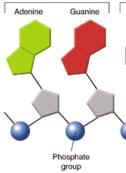 |
25.
Nitrogen bases made up of TWO RINGS are called ________________
|
26. Where in a eukaryotic cell does translation take place?
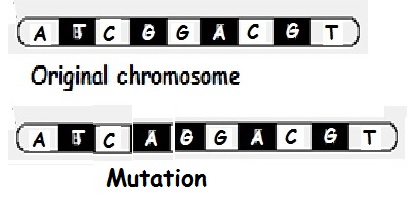 |
27. Name this kind of mutation.
|
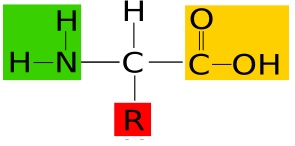 |
28. Name
this subunit used to build PROTEINS.
29. NAME THE CELL PART YOU LEARNED ABOUT THAT
RECEIVES THESE SUBUNITS FROM tRNA DURING TRANSLATION AND JOINS
THEM TOGETHER.
|
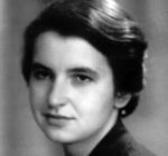
http://en.wikipedia.org/wiki/Rosalind_Franklin
|
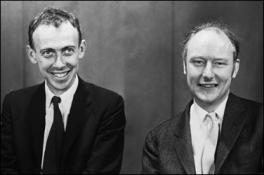
http://www.time.com/time/time100/scientist/profile/watsoncrick.html
|
30. Name the
woman whose X-ray pictures of DNA helped James Watson and Francis Crick to
figure out the structure of DNA.
31. Name the ENZYME involved in REPLICATION.
 |
32. In a DNA molecule, which two parts of the nucleotide make up the
SIDES OF THE LADDER?
33. What kind of bond holds the nitrogen bases together in the middle?
34. In a DNA molecule ADENINE always pairs up with _______________
|
35. Which of the following sequences shows the CENTRAL DOGMA OF BIOLOGY (how
information is passed on in cells)?
A. RNA → PROTEIN
→ DNA→
TRAIT
B. PROTEIN → DNA → TRAIT →
RNA
C. DNA
→ RNA → PROTEIN →
TRAIT
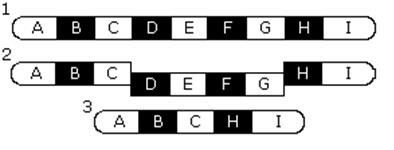 |
36. Name the kind of mutation shown in the diagram at the left. |
37. The place on the DNA where RNA polymerase attaches and starts reading
the information is called the ____________.
38. __________________ are sometimes called “jumping genes” and are involved in
increasing mutation rates when an organism is stressed.
 |
39. The two strands in a DNA molecule are called
_____________ because they run in opposite directions. |
40. ______________ mutations are caused by adding or deleting bases that
are NOT multiples of three and which causes the reading frame to regroup and be
read incorrectly.
41. When this type of mutation happens at the ____________ of a gene it causes
more damage and changes more of the protein
end beginning
42. When a repressor protein is attached to the __________________, the
lac operon genes are turned OFF.
 |
43. _________
genes control the growth and differentiation of cells and the
sequence of development in embryos of all animals.
|
44. Epigenetics studies differences in gene expression that are NOT due to
changing the DNA code itself, but how environment can change whether genes turn
on or off. Adding METHYL tags to DNA turns genes _______.
ON
OFF
45. When the repressor attaches to
_______________ , the lac operon turns ON.
46. In what kind of cell would you find a TATA box?
PROKARYOTE
EUKARYOTE
CHECK ANSWERS
ANSWERS
1.replication
2. uracil
3. DNA polymerase
4. nucleosome
5. histone
6. transcription
7. in nucleus
8. serine-arginine-valine
9. tRNA
10. mRNA
11. codon
12. ribosomes
| 13. |
|
| DNA |
RLNA |
| Double stranded |
Single stranded |
| Uses deoxyribose |
Uses ribose |
| Uses A, T, C, G |
Uses A, U, C, G |
| No Uracil |
No thymine |
| Has genetic code |
Carries info from DNA to cell; makes proteins |
| Found in nucleus in eukaryotes |
Made in nucleus; used in cytoplasm |
14. RNA polymerase
15. introns
16. chromatin
17. guanine
18. translation
19. nucleotide
20. T A A C G G T C G
21. t-RNA
22. Amino acid
23. False ; mutations that increase
survival
and reproduction can be helpful
24. translation
25. purines
26. On ribosomes in cytoplasm
27. Insertion
(this would also cause a frameshift)
28. Amino acid
29. Ribosome
30. Rosalind Franklin
31. DNA polymerase
32. phosphates & sugars
33. Hydrogen bonds
34. Thymine
35. C-
DNA
→ RNA
→
PROTEIN
→
TRAIT
36. Deletion
37. promoter
38.transposons
39. antiparallel
40. frameshift
41. beginning
42. operator
43. HOX
44. OFF
45. Lactose
46. Eukaryote
















